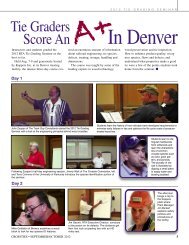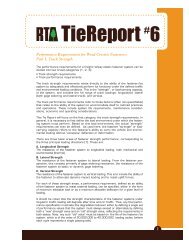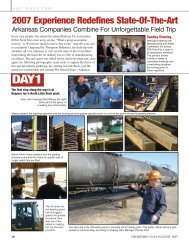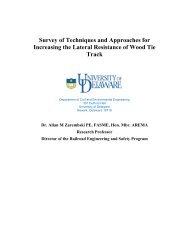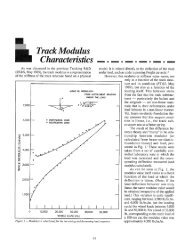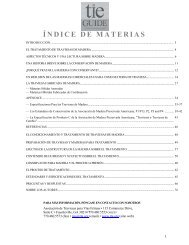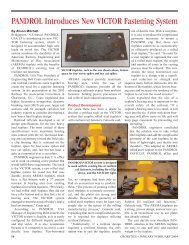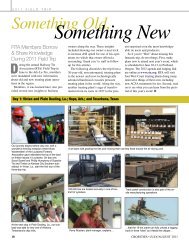Tie Dual Treatments with TimBor and Creosote or Copper ...
Tie Dual Treatments with TimBor and Creosote or Copper ...
Tie Dual Treatments with TimBor and Creosote or Copper ...
Create successful ePaper yourself
Turn your PDF publications into a flip-book with our unique Google optimized e-Paper software.
RESEARCH & DEVELOPMENT<br />
<strong>Tie</strong> <strong>Dual</strong> <strong>Treatments</strong> <strong>with</strong> <strong>TimB<strong>or</strong></strong> <strong>and</strong> <strong>Creosote</strong> <strong>or</strong> <strong>Copper</strong> Naphthenate<br />
20 Years Of Exposure In AWPA Hazard Zone 4<br />
By Terry L. Amburgey, TASKpro, LLC<br />
& Michael G. S<strong>and</strong>ers, F<strong>or</strong>est<br />
Products Department, Mississippi<br />
State University<br />
Introduction<br />
In the spring of 1985, Lonnie H. Williams<br />
(USDA F<strong>or</strong>est Service, Southern F<strong>or</strong>est<br />
Experiment Station) <strong>and</strong> Terry L. Amburgey<br />
(Mississippi State University, MSU)<br />
designed a series of tests to determine the<br />
utility of b<strong>or</strong>ate dip-diffusion treatments in<br />
protecting a variety of wooden products.<br />
One of these studies conducted at MSU<br />
in the summer <strong>and</strong> fall of 1985 was begun<br />
to test the hypothesis that b<strong>or</strong>ate dip-diffusion<br />
treatments of unseasoned crossties<br />
would protect them from decay fungi <strong>and</strong><br />
insects during air seasoning. The study also<br />
sought to test whether the treatments would<br />
protect the interi<strong>or</strong>s of “treated” ties as<br />
checks <strong>and</strong> splits develop, provided that the<br />
b<strong>or</strong>ate remains mobile following subsequent<br />
treatment <strong>with</strong> oil <strong>or</strong> oil-b<strong>or</strong>ne preservatives<br />
rather than being “fixed” in the wood. There<br />
is extensive w<strong>or</strong>ldwide literature attesting to<br />
the efficacies of b<strong>or</strong>ates f<strong>or</strong> protecting wood<br />
products from decay, fungi <strong>and</strong> insects<br />
(Drysdale 1994; Barnes et al 1989; Carr<br />
1959; Cockcroft <strong>and</strong> Levy 1973). Rather<br />
than coating the cellular surfaces of dry<br />
wood, as <strong>with</strong> conventional treatment<br />
processes, b<strong>or</strong>ates diffuse through the cell<br />
walls of wood that has not been dried.<br />
It was recognized that preservative-treated<br />
crossties provide long <strong>and</strong> valuable service<br />
to the railroad industry, <strong>with</strong> an estimated<br />
service life approaching 47 years (Anon.<br />
1975). While wood ties have perf<strong>or</strong>med<br />
well (Miller <strong>and</strong> Houghton, 1981), those<br />
made from refract<strong>or</strong>y species (e.g., white<br />
oak) are failing after as few as seven years<br />
in AWPA hazard zones 4 <strong>and</strong> 5. <strong>Tie</strong>s of<br />
refract<strong>or</strong>y species often have a relatively<br />
narrow b<strong>and</strong> of treated shell <strong>or</strong> sapwood<br />
surrounding a decay-susceptible heartwood<br />
c<strong>or</strong>e (Graham 1954, 1956; Graham <strong>and</strong><br />
Miller 1964; Miller 1961). As long as the<br />
treated shell remains intact, these ties perf<strong>or</strong>m<br />
adequately. However, development of<br />
checks/splits <strong>or</strong> processes such as driving<br />
spikes <strong>or</strong> drilling holes f<strong>or</strong> spikes <strong>or</strong> other<br />
hardware after preservative treatment permit<br />
moisture to enter the wood <strong>and</strong> decay fungi<br />
20<br />
<strong>and</strong>/<strong>or</strong> conditions conducive to “iron sickness”<br />
(spike kill) to become established<br />
(acidic wood + ferrous metal + water =<br />
c<strong>or</strong>rosion of iron <strong>and</strong> deteri<strong>or</strong>ation of<br />
adjacent wood).<br />
While it has been estimated that decay<br />
accounts f<strong>or</strong> only 18 to 35% of tie failures<br />
(Bescher 1977), decay fungi have a significant<br />
influence on many imp<strong>or</strong>tant wood<br />
properties <strong>and</strong>, likely, when deteri<strong>or</strong>ation is<br />
not readily visible in early stages of decay,<br />
mechanical tie failures are influenced by<br />
strength losses caused by decay fungi. Thus,<br />
many losses attributed to crushing, plate cut,<br />
spike kill <strong>or</strong> splits may in fact be due to<br />
decay. Treatment procedures that result in<br />
the penetration of preservatives throughout<br />
most <strong>or</strong> all of the cross sections would significantly<br />
decrease these pre-mature failures.<br />
In addition, mechanical defects may permit<br />
entry of additional decay fungi that, in turn,<br />
accelerate mechanical failures.<br />
Once decay fungi are found in ties, the<br />
next procedure is to effect control. While<br />
control can be expensive, the benefits of<br />
prolonging tie service life can be considerable,<br />
estimated in 1985 at $5 per tie per year<br />
of extended life (Anon. 1985). This figure<br />
would be much greater today.<br />
Methods<br />
Unseasoned white oak, red oak <strong>and</strong> gum<br />
ties donated by Kerr-McGee, Columbus,<br />
Miss., were either placed in air-seasoning<br />
piles <strong>with</strong> no treatment <strong>or</strong> given either a single<br />
<strong>or</strong> double one-minute dip in solutions of<br />
one of four b<strong>or</strong>ate solutions: <strong>TimB<strong>or</strong></strong>®<br />
(35% BAE), Am-B<strong>or</strong>-S® (25% BAE), Am-<br />
B<strong>or</strong>-P® (26% BAE), KM-B<strong>or</strong>® (40%<br />
BAE). Each of these solutions contained 1%<br />
Busan 1030 as a mold inhibit<strong>or</strong>, since<br />
b<strong>or</strong>ates are known to have limited effect on<br />
the growth of mold <strong>and</strong> soft-rot fungi<br />
(Amburgey 1990); some ties were dipped in<br />
only Busan 1030. The <strong>TimB<strong>or</strong></strong>®, Am-B<strong>or</strong>-<br />
S® <strong>and</strong> KM-B<strong>or</strong>® were heated to approximately<br />
130F bef<strong>or</strong>e use. Since, to our<br />
knowledge, the other b<strong>or</strong>ate f<strong>or</strong>mulations no<br />
longer are commercially available, only the<br />
<strong>TimB<strong>or</strong></strong>® data will be presented herein.<br />
The dipped ties were stacked <strong>and</strong> covered<br />
<strong>with</strong> polyethylene f<strong>or</strong> four weeks of diffusion.<br />
The ties given a double dip were<br />
dipped f<strong>or</strong> one minute on each of two consecutive<br />
days <strong>and</strong> were bulk-stacked <strong>and</strong><br />
covered to prevent drying (aid diffusion)<br />
between dips. Following diffusion st<strong>or</strong>age,<br />
ties were stacked near the untreated ties f<strong>or</strong><br />
air-drying. During air seasoning, it became<br />
apparent that the b<strong>or</strong>ate-Busan <strong>and</strong> Busanonly<br />
ties remained bright in col<strong>or</strong> whereas<br />
the untreated ties were dark gray to black,<br />
indicating that the b<strong>or</strong>ates <strong>and</strong> Busan were<br />
protecting the ties from colonization by<br />
mold <strong>and</strong> sapstain fungi.<br />
After air-seasoning, analysis of c<strong>or</strong>es<br />
taken from the mid-points of treated ties<br />
confirmed that b<strong>or</strong>ates diffused into the ➤<br />
Table 1. Average b<strong>or</strong>ic acid content of increment c<strong>or</strong>es taken from<br />
the midpoint of gum, red oak <strong>and</strong> white oak crossties treated while<br />
unseasoned by dip-diffusion <strong>with</strong> <strong>TimB<strong>or</strong></strong> ® (35% BAE at 130 F).<br />
Species Dips …………………….Assay Zone………………………………<br />
(a) 0 – 0.5 in. 0.5 – 1.5 in. 1.5 – 2.5 in.<br />
pcf (b) %BAE (c)pcf %BAE pcf %BAE<br />
Gum 1 0.162 0.498 0.016 0.051 0.007 0.022<br />
2 0.237 0.731 0.023 0.072 0.002 0.007<br />
Red Oak 1 0.103 0.281 0.025 0.067 0.001 0.005<br />
2 0.203 0.551 0.023 0.038 0.002 0.004<br />
White Oak 1 0.105 0.248 0.006 0.015 0.002 0.004<br />
2 0.195 0.460 0.017 0.041 0.004 0.010<br />
a/ Number of 1-min. dips in 130F solution (on each of 2 consecutive days; bulk-stacked between dips).<br />
b/ Pounds per cubic foot as b<strong>or</strong>ic acid.<br />
c/ Percent b<strong>or</strong>ic acid equivalent. Calculations based on Wood H<strong>and</strong>book (USDA F<strong>or</strong>est Service) specific gravity values: sweetgum, 0.52; southern red oak,<br />
0.59; white oak, 0.68.<br />
CROSSTIES • NOVEMBER/DECEMBER 2009
RESEARCH & DEVELOPMENT<br />
ties <strong>and</strong> that the double-dip procedure<br />
resulted in approximately twice the retention<br />
of b<strong>or</strong>ate as compared to the ties given<br />
a single dip (Table 1).<br />
A p<strong>or</strong>tion of the b<strong>or</strong>ate-treated <strong>and</strong><br />
untreated air-dried ties were treated <strong>with</strong><br />
creosote (Kerr-McGee in Columbus, MS),<br />
copper naphthenate (Mooney Chemicals<br />
f<strong>or</strong>mulation in fuel oil), <strong>or</strong> remained<br />
untreated. Some b<strong>or</strong>ate-Busan 1009<br />
(Buckman Lab<strong>or</strong>at<strong>or</strong>ies) <strong>and</strong> Busan-only<br />
treated ties were not subsequently treated<br />
<strong>with</strong> creosote <strong>or</strong> copper naphthenate. All ties<br />
were placed on a washed gravel bed at the<br />
MSU D<strong>or</strong>man Lake field exposure test site<br />
in June 1986. A spike was driven into one<br />
end of ties <strong>with</strong>in each treatment group to<br />
determine the effects of treatments on iron<br />
deteri<strong>or</strong>ation (spike kill). After one year of<br />
exposure, a p<strong>or</strong>tion of the ties per species in<br />
each treatment group were inoculated <strong>with</strong><br />
active cultures of either Lentinus lepideus<br />
(brown-rot) <strong>or</strong> Trametes versicol<strong>or</strong> (whiterot)<br />
basidiomycete decay fungi near the<br />
midpoint. Three-inch long 0.5 inch diameter<br />
wood dowels inoculated <strong>with</strong> the test fungi<br />
<strong>and</strong> grown under sterile conditions were<br />
placed in three-inch deep holes drilled near<br />
the tie midpoints.<br />
Results<br />
After 20 years of exposure, approximately<br />
six to eight inches of pine straw were swept<br />
from the tie surfaces pri<strong>or</strong> to inspection.<br />
Sample ties from selected groups (none<br />
from those pre-treated <strong>with</strong> Am-B<strong>or</strong>-S®,<br />
Am-B<strong>or</strong>-P® <strong>or</strong> KM-B<strong>or</strong>®) were removed,<br />
visually examined, segmented to check f<strong>or</strong><br />
internal decay, <strong>and</strong> sprayed <strong>with</strong> b<strong>or</strong>on indicat<strong>or</strong><br />
(AWPA 2006). Following internal<br />
inspections <strong>and</strong> spraying <strong>with</strong> b<strong>or</strong>on indicat<strong>or</strong>,<br />
it was observed that ties given either a<br />
one- <strong>or</strong> two-minute b<strong>or</strong>ate dip <strong>and</strong> subsequently<br />
treated <strong>with</strong> creosote <strong>or</strong> copper<br />
naphthenate had no insect damage <strong>and</strong> little<br />
<strong>or</strong> no internal decay, even in those inoculated<br />
<strong>with</strong> L. lepideus <strong>and</strong> T. versicol<strong>or</strong>. The<br />
decay fungi in the treated dowels moved<br />
only a very sh<strong>or</strong>t distance f<strong>or</strong>m the dowel<br />
bef<strong>or</strong>e being controlled by the b<strong>or</strong>ates in the<br />
tie interi<strong>or</strong>s. The surfaces of the b<strong>or</strong>ate-creosote<br />
ties looked better than those of the<br />
b<strong>or</strong>ate-copper naphthenate ties, presumably<br />
because the creosote provided greater protection<br />
from soft-rot fungi growing under<br />
the pine straw than did copper naphthenate.<br />
However, this difference in surface appearance<br />
had no relation to internal decay of the<br />
ties (Table 2).<br />
The inoculated decay fungi did become<br />
established in the ties not pre-treated <strong>with</strong><br />
b<strong>or</strong>ate. Most of the b<strong>or</strong>ate-creosote <strong>or</strong><br />
b<strong>or</strong>ate-copper naphthenate ties, <strong>and</strong> some of<br />
the red oak <strong>and</strong> white oak ties given only a<br />
Table 2 – Perf<strong>or</strong>mance ratings f<strong>or</strong> ties <strong>with</strong> 20 years<br />
of exposure in AWPA hazard zone four.<br />
<strong>Treatments</strong>(a) Species Exteri<strong>or</strong> Rating(b) Interi<strong>or</strong> Rating(b) Loose Spikes<br />
Untreated Gum 0 0 All<br />
Red oak 0 0 All<br />
White oak 0 0 All<br />
<strong>Creosote</strong> Gum 9.8 9.4 0<br />
Red oak 8.6 8.5 0<br />
White oak 8.5 8.0 0<br />
CuNap Gum 6.0 8.0 0<br />
Red oak 6.5 4.0 1<br />
White oak 7.0 5.7 0<br />
<strong>TimB<strong>or</strong></strong> Gum 0 0 5<br />
Red oak 2.0 1.1 2<br />
White oak 3.0 2.3 3<br />
<strong>TimB<strong>or</strong></strong>-<strong>Creosote</strong> Gum 9.3 9.4 1<br />
Red oak 8.3 10.0 0<br />
White oak 8.8 9.6 0<br />
<strong>TimB<strong>or</strong></strong>-CuNap Gum 8.0 9.7 0<br />
Red oak 7.7 10.0 0<br />
a <strong>Creosote</strong> , CuNap = cooper naphthenate, <strong>TimB<strong>or</strong></strong> = b<strong>or</strong>ate<br />
b Average AWPA rating (10 = no deteri<strong>or</strong>ation, 0 = failure)<br />
White oak 7.2 8.8 0<br />
b<strong>or</strong>ate treatment, retained sufficient b<strong>or</strong>ate<br />
after 20 years to flash red when sprayed<br />
<strong>with</strong> indicat<strong>or</strong>. This puts to rest the myth<br />
that b<strong>or</strong>ates leach out as rapidly as they diffuse<br />
into wood products. The col<strong>or</strong>ation of<br />
the indicat<strong>or</strong> indicates the presence of b<strong>or</strong>on<br />
at levels equal to <strong>or</strong> greater than 0.80 kg/m3<br />
(0.049 pcf) (AWPA 2006). Most of the<br />
<strong>TimB<strong>or</strong></strong>–only treated ties were not serviceable.<br />
Untreated ties were essentially compost,<br />
except f<strong>or</strong> p<strong>or</strong>tions of white-oak heartwood.<br />
From these results, one must conclude<br />
that the test hypothesis that pre-treatment<br />
<strong>with</strong> b<strong>or</strong>ates will protect the interi<strong>or</strong>s of ties<br />
from decay fungi <strong>and</strong> insects during air seasoning<br />
<strong>and</strong> in service is c<strong>or</strong>rect, if a subsequent<br />
treatment is used to prevent b<strong>or</strong>ate<br />
leaching <strong>and</strong> to control soft-rot fungi. In<br />
addition, the lack of spike kill in b<strong>or</strong>ate<br />
pre-treated ties confirms observations that<br />
b<strong>or</strong>ate-treated wood is not c<strong>or</strong>rosive to<br />
ferrous metals. These results verify those<br />
obtained using b<strong>or</strong>ate-treated ties subsequently<br />
treated <strong>with</strong> creosote <strong>and</strong> exposed<br />
on active rail lines (Amburgey, Watt <strong>and</strong><br />
S<strong>and</strong>ers 2003). §<br />
Literature Cited<br />
Amburgey, T. L. 1990. The need f<strong>or</strong> co-biocides when treating wood <strong>with</strong><br />
b<strong>or</strong>ates, p. 51-52. IN: Hamel, M. <strong>and</strong> D. Robertson (eds.). First International<br />
Conference on Wood Protection <strong>with</strong> Diffusible Preservatives. Proceedings #<br />
47355, F<strong>or</strong>est Products Society, Madison, WI. 141p. (ISBN 0-935018-49-2).<br />
Amburgey, T. L., J. L. Watt, <strong>and</strong> M. G. S<strong>and</strong>ers. 2003. Extending the service<br />
life of wooden crossties by using pre- <strong>and</strong> supplemental preservative treatments.<br />
15- year exposure rep<strong>or</strong>t. Crossties (May/June): 1 -5.<br />
Amburgey, T. L. <strong>and</strong> M. G. S<strong>and</strong>ers. 2007. B<strong>or</strong>ate pre-treated crossties…a 20-<br />
year field test. Proceedings, American Wood Protection Association 103: 109-<br />
111.<br />
Anon. 1975. Cross tie insertions. Crossties 56(10):57.<br />
Anon. 1985. Addressing bad-tie clustering. Railway Track <strong>and</strong> Structures.<br />
August, p. 21 – 25.<br />
American Wood-Preservers’ Association. 2006. St<strong>and</strong>ard A3-05, part 17,<br />
“St<strong>and</strong>ard method f<strong>or</strong> determining penetration of b<strong>or</strong>on-containing preservatives<br />
<strong>and</strong> fire retardants.” Book of St<strong>and</strong>ards. Birmingham, Ala.<br />
Barnes, H. M., T. L. Amburgey, L. H. Williams, <strong>and</strong> J. J. M<strong>or</strong>rell. 1989. B<strong>or</strong>ates<br />
as wood preserving compounds; the status of research in the United States.<br />
International Research Group on Wood Preservation, Doc. No. IRG/WP/3542.<br />
Bescher, R. H. 1977. <strong>Creosote</strong> crossties. Proceedings, American Wood-<br />
Preservers’ Association 73:117-125.<br />
Carr, D. R. 1959. B<strong>or</strong>on as a wood preservative. Proceedings, Annual<br />
Convention of the British Wood Preserving Association, 1 – 18.<br />
Cockcroft, R. <strong>and</strong> J. F. Levy. 1973. Bibliography on the use of b<strong>or</strong>on compounds<br />
in the preservation of wood. Journal, Institute of Wood Science, No. 33<br />
(6)3: 28-37.<br />
Drysdale, J. A. 1994. B<strong>or</strong>on treatments f<strong>or</strong> the preservation of wood – A review<br />
of efficacy data f<strong>or</strong> fungi <strong>and</strong> termites.<br />
Graham, R.; D. 1954. The air seasoning <strong>and</strong> preservative treatment of cross<br />
ties from eight Oregon conifers. Proceedings, American Wood-Preservers’<br />
Association 50:175-184.<br />
Graham, R. Dl. 1956. The preservative treatment of eight Oregon conifers by<br />
pressure processes. Proceedings, American Wood-Preservers’ Association<br />
52:117-138.<br />
Graham, R. D. <strong>and</strong> D. J;. Miller. 1964. Service of crossties from Oregon woods.<br />
Proceedings, American Wood-Preservers’ Association 60:27-30.<br />
Miller, D. J. 1961. Oregon woods f<strong>or</strong> crossties. F<strong>or</strong>est Products Journal<br />
11(12):579-582.<br />
Miller, D. J. <strong>and</strong> P. R. Houghton. 1981. Perf<strong>or</strong>mance of western wood species<br />
as crossties in mainline railroad track. F<strong>or</strong>est Products Journal 31(5):51-58.<br />
22 CROSSTIES • NOVEMBER/DECEMBER 2009



